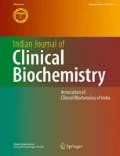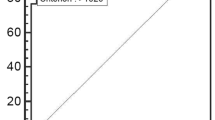Abstract
Recent acquisitions on the early detection and monitoring of the progression of diabetic complications (nephropathy) using the techniques of enzymology (lysosomal enzymes) are reviewed. it appears that the kidney is the principal source of urinary lysosomal enzymes. Urinary samples for lysosomal enzyme determination can be either 24-hour or spot-collection. The use of synthetic substrates (4-methylumbelliferyl substrates) provides an easy, inexpensive, sensitive and highly reproducible method of lysosomal enzyme assay. It is recommended that more than one enzyme be assayed in the process. The use of fractional enzyme excretion (FEE) ratios is further recommended. The urinary lysosomal glycosidases investigated and found to be of particular diagnostic value in the early detection of diabetic nephropathy include N-acetyl-β-D-glucosaminidase (β-hexosaminidase, NAG), β-glucuronidase and β-galactosidase, with NAG being the most useful indicator. Urinary NAG can be used in monitoring the progression of diabetic nephropathy. The fluorimetric assay of lysosomal glycosidases is particuarly recommended in developing countries since it is simple, sensitive and inexpensive.
Similar content being viewed by others
References
Cheesbrough, M. (1991), Medical Laboratory Manual for Tropical Countries, 2nd edn. Educational Low-Price Books Scheme, Cambridge vol 1, p. 527–545.
Howards, B.V. (1987) Lipoprotein metabolism in diabetes mellitus. J. Lipid Res. 28, 613–623.
Adoga, G.I. and Glew, R.H. (1995) Lysosomal enzymes in the diagnosis and management of complications in diabetes mellitus. International Diabetes Digest, 12–15.
Dalla, V.M., Saller, A., Bortoloso, E., Mauer, M., Fioretto, P. (2000) Structural involvement in type 1 and type 2 diabetic nephropathy. Diabetes Metab. 26(4), 8–14.
Moriya, T., Tanaka, K. and Moriya R. (2000) Glomerular structural changes and structural-functional relationships at early stage of diabetic nephropathy in Japanese type 2 diabetic patients. Med. Electron Microsc. 33(3), 115–22.
Tarchini, R., Bottini, E., Botti, P., Marseglia, C.D., Talassi, E., Baraldi, O., Lambertini, D., Gaetti, L. and Bellomi, A. (2005) Type 2 diabetic nephropathy: evolution and prevention. G. Ital. Nefrol. 22(31), 15–19.
Al-Hermi, B.E., Al-Abbasi, A.M., Rajab, M.H., Al-Jenaidi, F.A. and Al-Ekri, Z.E. (2005) Diabetic nephropathy in children with type 1 diabetes mellitus in Bahrain. Saudi Med J. 26(2), 294–297.
Garba, I.H., Ubom, G., Gatsing, D. and Awwal, M. (2005) Acid phosphatase activity as a potential prognostic marker in patients with benign prostate hyperplasia (BPH) The Internet Journal of Surgery 6(1).
Garba, I.H., Gatsing, D., Awwal and Gadzama, J. (2005) Alanine and aspartate transaminases in the serum of acute appendicitis patients before and after surgery. The Internet Journal of Gastroenterology 4(1).
Gatsing, D. and Adoga, G.I. (2004) Lysosomal enzymuria in the diagnosis and monitoring of diabetic nephropathy. L'Eurobiologiste Tome XXXV, No 271, 1–4.
Gorog, O. and Pearson, J.D. (1985) Sialic acid moieties on surface glycoproteins protect endothelial cells from prolytic damage. J. Pathol. 146, 205–212.
Yazzie, D., Adoga, G.I., Okolo, A., Szlachetka, R., Fry, D., and Glew, R.H. (1995) Decreased urinary excretion of β-glucuronidase in sickle cell anemia in Nigeria. Renal Failure 17(1), 57–64.
Lombardo, A., Caimi, L., Marchesini, S., Goi, G.C., and Tettamanti, G. (1980) Enzymes of lysosomal origin in human plasma and serum: assay conditions and parameters influencing the assay. Clin. Chim. Acta 108, 337–346.
Maruhn, D. (1979) Preparation of urine for enzyme determinations by gel filtration, in diagnostic significance of enzymes and proteins in urine. Hans-Huber, Berne, p. 22.
Price, R.G. (1982) Urinary enzymes, nephrotoxicity and renal disease. Toxicology 23, 99–134.
Vander Jagt D.J., Steinberg, B.R. and Glew, R.H. (1992) Comparison of urinary excretion of four lysosomal hydrolases in healthy elderly and young adults. Clin. Chim. Acta 210, 47–54.
Maruhn, D., Strozyk, K., Gielow, L., and Bokc, K.D. (1977) Diurnal variations of urinary enzyme excretion. Clin. Chim. Acta 75, 427–433.
Stroo, W.E. and Hook, J.B. (1977) Enzymes of renal origin in urine as indicators of nephrotoxicity. Toxicol. Appl. Pharmacol. 39, 423–434.
Dingle, J.T. (1972), Lysosomes: A Laboratory hand book. North-Holland Publishing Company, 188 p.
Balami, D., Adoga, G.I. and Okpe, S.E. (1998) Changes in lysosomal enzymes activities in paediatric patients in Jos, Nigeria. West African Journal of Biological Sciences 7, 156–160.
Gatsing, D., Adoga, G.I., Garba, I.H., Obekpa, P. and Towa, Y.K. (2000) The use of acid phosphatase in the monitoring of laryngeal carcinoma. L'Eurobiologiste Tome XXXIV, No 248–249, 31–34.
Gatsing, D., Adoga, G.I. and Obekpa, P. (2002) b-Glucuronidase, b-galactosidase, and acid phosphatase activities in liposarcoma patients before and after surgical intervention. L'Eurobiologiste Tome XXXV, No 259, 11–14.
Gatsing, D., Adoga, G.I., Dondji, B. and Obekpa, P. (2003) Effect of surgical intervention on levels of β-galactosidase and b-glucuronidase in patients with prostatic carcinoma. Ann. Fac. Sci. Ydé I 35(2), 29–32.
Berty, R.M., Adler, S., Basu, A. and Glew, R.H. (1990) Effect of acid-base changes on urinary hydrolases in Fabry's disease after renal transplantation. J. Lab. Clin. Med. 115, 696–703.
Kunin, C.M., Chesney, R.W., Craig, W.A., England, A.C. and De Angelis, C. (1978) Enzymuria as a marker of renal injury and disease: Studies of N-acetyl-β-D-glucosaminidase in the general population and in patients with renal disease. Paediatrics 62, 751–760.
Tombach B, Bremer, C., Reimer, P., Kisters, K., Schaefer, R.M., Geens, V. and Heindel, W. (2001) Contrast mediarenal tolerance of a neutral gadolinium chelate (gadobutrol) in patients with chronic renal failure: results of a randomized study 1. Radiology 218, 651–657
Obatomi, D.K. and Plummer, D.T. (1990) Amelioration of gentamicin nephrotoxicity by cefuroxime. Med. Sci. Res. 18, 593–594.
Kelly, L. and Woodard, S.H. (1988) Alternations in the activities of lysosomal glycosidases in human diabetic. Medical Science Research 16, 491–496.
Salema, M.A.K., El-Habashya, S.A., Saeidb, O.M., El-Tawila, M.M.K. and Tawfikc, P.H. (2002) Urinary excretion of n-acetyl—d-glucosaminidase and retinol binding protein as alternative indicators of nephropathy in patients with type 1 diabetes mellitus. Pediatric Diabetes 3(1), 37.
Baggio, B., Brianu, G. and Cicerello, E. (1986) Urinary glycosaminoglycans, sialic acid and lysosomal enzymes increase in nonalbuminuric diabetic patients. Nephron 43, 187–190.
Bomback, F.M., Nakagawa, S., Kumin, S. and Nitowsky, H.M. (1976) Altered lysosomal glycohydrolase activities in juvenile diabetes mellitus. Diabetes 25, 420–427.
Dedov, I.I., Mukhin, N.A., Pal'tsev, M.A., Delektorskaia, L.N. and Shestakova, M.V. (1989) Urinary enzymes as a marker of the preclinical stage of diabetic nephropathy. Ter. Arkh. 61(12), 73–76.
Chouinard, S., Viau, C. and Greselin, E. (1992) Enzymuria and tubular proteinuria in diabetic rats: a 12-week follow-up study. Ren. Fail. 14(1), 41–47.
Minakami, H. (1992) Clinical evaluation of N-acetyl-β-D-glucosaminidase on prediction of diabetic nephropathy. Hokkaido Igaku Zasshi. 67(2), 234–246.
Ikenaga, H., Suzuki, H., Ishii, N., Itoh, H. and Saruta, T. (1993) Enzymuria in non-insulin-dependent diabetic patients: signs of tubular cell dysfunction. Clin. Sci. 84(4), 469–475.
Golov, K.G., Varshavskii, V.A., Okunev, D.I.U., Neverov, N.I., Shestakova, M.V., and Proskurneva, F.P. (1995) Urinary enzymes in the assessment of the early stage of kidney involvement in psoriasis and diabetes mellitus. Ter. Arkh. 67(10), 80–81
Maisant, A., Sitzmann, F.C. and Strohlein, S. (1993) N-acetyl-β-glucosaminidase (β-NAG) in urine: a parameter for early detection of diabetogenic nephropathy in childhood. Padiatr. Padol. 28(3), 77–80.
Nosadini, R. (2002) Hypertension and renal complications in type 2 diabetes. Semin. Vasc. Med. 2(1), 109–119.
Groop, L., Stenman, S., Groop, P.H., Makipernaa, A. and Teppo, A.M. (1990) The effect of exercise on urinary excretion of different size proteins in patients with insulin-dependent diabetes mellitus. Scand. J. Clin. Lab. Invest. 50, 525–532.
Muirhead, N. (1988). The kidney as an endocrine organ. In: Catto, G.R.D. and Power, D.A. (eds.). Nephrology in clinical practice. Edward Arnold, pp 50–71.
Reddi, A.S. and Jyothirmayi, G.N. (1993) Aldose reductase inhibition by ponalrestat (statil) does not prevent proteinuria in long-term diabetic rats. Journal of Diabetes Complications 7(4), 233–240.
Parving, H.H., Tarnow, L. and Rossing, P. (1996) Genetics of diabetic nephropathy. J. Am. Soc. Nephrol. 7(12), 2509–2517
Wang, P.H., Lau, J. and Chalmers, T.C. (1993) Meta-analysis of effects of intensive blood-glucose control on late complications of type I diabetes. Lancet 341(8856), 1306–1309
Dalla, V.M., Saller, A., Mauer, M. and Fioretto, P. (2001) Role of mesangial expansion in the pathogenesis of diabetic nephropathy. J. Nephrol. 14(4), 51–57.
Wei, P., Lane, P.H., Lane, J.T., Padanilam, B.J. and Sansom, S.C. (2004) Glomerular structural and functional changes in a high-fat diet mouse model of early-stage Type 2 diabetes. Diabetologia 47(9), 1541–1549.
Materson, B.J. and Preston, R.A. (1997) Prevention of diabetic nephropathy. Hosp. Pract. (Off Ed) 32(2), 129–134, 139–140.
Maeda, M., Yabuki, A., Suzuki, S., Matsumoto, M., Taniguchi, K. and Nishinakagawa, H. (2003) Renal lesions in spontaneous insulin-dependent diabetes mellitus in the nonobese diabetic mouse: acute phase of diabetes. Vet. Pathol. 40(2), 187–195
Molnar, M., Wittmann, I. and Nagy, J. (2000) Prevalence, course and risk factors of diabetic nephropathy in type-2 diabetes mellitus. Med. Sci. Monit. 6(5), 929–936
Naidoo, D.P. (2002) The link between microalbuminuria, endothelial dysfunction and cardiovascular disease in diabetes. Cardiovasc. J. S. Afr. 13(4), 194–199.
Chen, L., Jia, R.H., Qiu, C.J. and Ding, G. (2005) Hyperglycemia inhibits the uptake of dehydroascorbate in tubular epithelial cell. Am. J. Nephrol. 25(5), 459–465.
Beisswenger, P.J., Drummond, K.S., Nelson, R.G., Howell, S.K., Szwergold, B.S. and Mauer, M. (2005) Susceptibility to diabetic nephropathy is related to dicarbonyl and oxidative stress. Diabetes 54(11), 3274–3281.
Author information
Authors and Affiliations
Corresponding author
Rights and permissions
About this article
Cite this article
Gatsing, D., Garba, I.H. & Adoga, G.I. The use of lysosomal enzymuria in the early detection and monitoring of the progression of diabetic nephropathy. Indian J Clin Biochem 21, 42–48 (2006). https://doi.org/10.1007/BF02912910
Issue Date:
DOI: https://doi.org/10.1007/BF02912910




